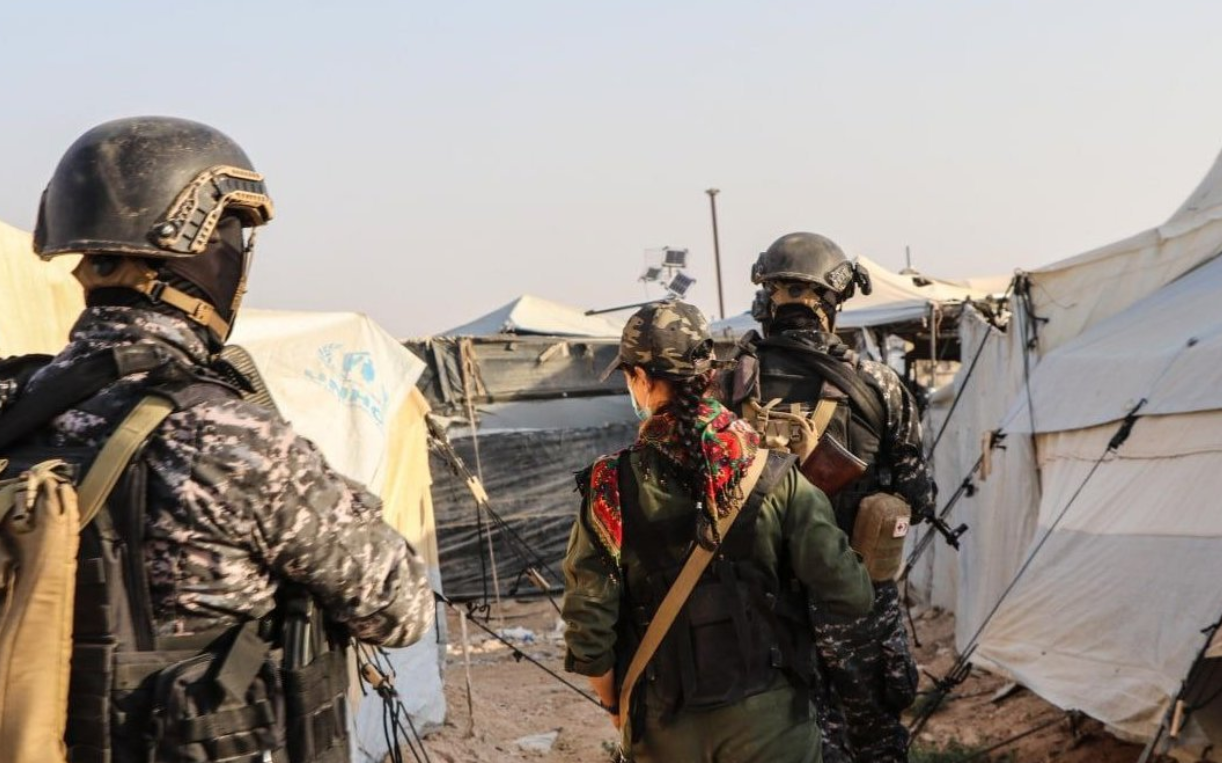August Sleeper Cell Report: rising threat level in Hol camp prompts ‘Operation Humanity and Security’

Asayish during ‘Operation Humanity and Security’.
- The ongoing ‘Operation Humanity and Security’ in Hol camp yielded 121 arrests in the month of August.
- Outside of Hol camp, sleeper cell attacks and casualties increased slightly from July.
- Inside of Hol camp, murders remained low; ISIS has largely shifted strategy, planning more infrequent, but large-scale, attacks rather than frequent small-scale ones.
After a month of relative quiet in July, the number of casualties from ISIS sleeper cell attacks rose again in August. This month, 24 sleeper cell attacks outside of Hol camp killed 21 people (14 military, 4 civilians) and wounded a further 21 (19 military, 2 civilians), mostly in the vicinity of Deir ez-Zor. Inside Hol camp, 1 attack killed 3 civilians.
In late August, the Internal Security Forces of NES (Asayish) began the second phase of ‘Operation Humanity and Security’ in al-Hol camp. The first phase was conducted back in April 2021. This is a large operation, requiring over 2,000 Asayish members, and it will continue into September. The first week of the operation ran from the 25th to the 31st of August. In this period, 121 suspected ISIS affiliates were arrested, 15 of whom were women. 119 tents were removed from the camp; according to the Asayish these tents were used as sites for ISIS to organise, recruit children, hold Sharia courts (videos of such activities previously occuring in the foreign annex have emerged, as documented in our June report), and commit crimes such as torturing. 48 mobile phones and tablets were confiscated, as were 2 hard disks and a laptop. Furthermore, weapons, ammunition, digging equipment, torture devices, a military uniform with the Turkish army insignia, and a Turkish flag were seized. 2 female Asayish members were lightly injured on the one occasion that detainees responded violently.

Asayish tent sweeps found military uniform with the Turkish insignia.
There were relatively few incidents in Hol camp this month. In early August, the Asayish thwarted an attempt to smuggle 17 women and 39 children out of the camp, who were said to be members of ISIS families. They also found 3 bodies: two Iraqi men and one Syrian who had been murdered. Despite this, camp officials have continually stated that they anticipate large attacks from ISIS cells in the near future, coordinated between cells inside and outside the camp. Indeed, both phases of ‘Operation Humanity and Security’ were initiated in response to rising security threats emanating from the camp. The Asayish declared that they are responding to the “escalating danger that al-Hol camp poses in terms of its transformation into a hotbed for ISIS cells”. Jinan Hanan, a camp administrator at Hol, stated that, “the situation here could explode at any moment, and this camp cannot be dealt with as a military prison or with soldiers, it is dealt with on the basis that there are civilians and innocent people, the situation will be catastrophic if something happens in the camp”. Imran Riza, the UN Resident and Humanitarian Coordinator for Syria, expressed deep concerns about the violence in Hol camp, and stated that “all countries that have nationals in these camps must find ways to repatriate them”, also adding that the camp is underfunded by approximately $45 million. Qassim al-Araji, Iraq’s National Security Advisor, also warned that the Asayish risk losing control of Hol camp, and spoke of the dangers this posed to the world. In this light, the camp administrators have called for greater international support both in terms of managing the situation on the ground in the camp and repatriating international detainees. Initial efforts made in this direction have been small. This month, 150 Iraqi families, comprising of 620 individuals, were repatriated. Iraq also repatriated 50 male ISIS-linked prisoners from prisons across NES. In addition, 400 people from Deir ez-Zor left Hol camp and returned home as part of AANES’ amnesty returns policy.
The Asayish have reported that evidence points to tight coordination between sleeper cells within and outside al-Hol camp. ISIS cells outside the camp reside and operate primarily in the Syrian Badia, across the Iraqi-Syrian border, as well as in the Turkish-occupied areas. The United Nations Counter-Terrorism chief Vladimir Voronkov, in a briefing to the UN Security Council, estimated that whilst ISIS only held $25-50 million in assets – a significant decrease from a few years ago – the border area between Syria and Iraq was still home to the operations of around 10,000 mobile fighters. This area is strategically used for training and planning, as ISIS cells enjoy relative ease of mobility here, and the SDF and Iraqi forces struggle to gain a foothold. As Crisis Group explained in a report from July, ISIS “adjusts its tactics to meet the varying degrees of SDF control from place to place. It keeps a low profile in Raqqa, where the SDF is stronger and where it fears provoking a U.S.-led coalition return, though it still uses the province as a conduit for smuggling of people, goods and weapons. By contrast, it is asserting itself more in Deir al-Zor, where the SDF is already struggling to maintain security”. In response to heightened activity by ISIS sleeper cells around the Syria-Iraqi border, both the SDF and Iraqi forces have increased the frequency and intensity of their patrols of the area.
Outside of Hol, there were 24 attacks by ISIS sleeper cells. An additional purported 11 attacks were claimed by ISIS, through their Amaq news channel, but the RIC could not independently verify these. In the Deir ez-Zor area, SDF members, checkpoints, and cars were continually targeted throughout August. In total, 10 SDF military personnel were killed, and 11 injured. AANES workers were also targeted with threats: local council and municipality staff in Deir ez-Zor were presented with a ‘hit-list’ from ISIS with their names written down, threatening to kill them if they did not quit working with the institutions of the Autonomous Administration. Most of those whose names were on the paper immediately resigned. On a later occasion, an AANES employee who had received text threats from ISIS to quit his job, was assassinated by gunmen on a motorcycle. Another incident saw the car carrying the Deir ez-Zor Military Council leader targeted, but no casualties were reported. Two separate attacks resulted in the killing of a young male civilian, and the death of a child and the wounding of his mother. In the Raqqa area, 2 military personnel were killed and 4 were injured, as SDF outposts were targeted. In the Jazira area, an al-Jabour tribal dignitary was assassinated inside his car, whilst 2 separate attacks saw 2 SDF military personnel killed and 4 injured.

SDF fighters at a checkpoint in Deir ez-Zor.
Aside from ‘Operation Humanity and Security’, the SDF conducted a relatively low number of raids this month. In Heseke, the Asayish arrested an ISIS militant who had partaken in the January attack on al-Sinaa Prison. They confiscated a machine gun, forged papers, and a mobile phone. In Deir ez-Zor, an SDF house raid led to the arrest of a former ISIS commander. During a raid inside Hol camp in early August, the Asayish found trenches reportedly used for ISIS members to hide in, as well as stash materials. Outside of pursuing ISIS, the SDF also launched an anti-smuggling raiding campaign in several villages across the western Deir ez-Zor countryside. This heightened tensions between the SDF and some communities in Deir ez-Zor. Residents of al-Sour town, north of Deir ez-Zor, and al-Ezbet city, and several other villages in the western Deir ez-Zor countryside, staged protests for several days, blocking roads with burning tyres, in response to the arrest of 27 members of the Deir ez-Zor Military Council who were linked to theft and accused of ‘communicating with outside parties’. The SDF later released some of the arrestees, after mediation of tribal notables and dignitaries. The dignitaries and elders of the al-Bakara tribe expressed their support for the SDF’s raids and committed to cooperating with the operations.

Asayish arrest an ISIS militant who had partaken in January’s al-Sinaa prison attack.
The SDF also reported that they carried out several successful raids against MIT sleeper cells. In Tel Barak, Heseke, the SDF raided an MIT cell, arrested 2 alleged agents, and killed a further 1, stating that the latter refused to surrender. Also in Heseke, the SDF arrested an MIT sleeper cell member who they claim had been about to carry out an IED attack. Beyond individual MIT cells, the influence of Turkey remains a critical thorn in the side of SDF’s attempts to engender stability and security in the region. The camp administrators of both Hol and Roj have detailed how the escalation of attacks and threats from Turkey detract much-needed resources from efforts to fight ISIS and maintain security inside camps of NES. Jinan Hanan expressed that, “Turkish interference in the region is leaving the region unsecure which again helps ISIS to organize themselves in Syria. This may weaken the monitoring of the [Hol] camp and the incidents of attempts to escape from the camp, at the same time weaken the engagement of the SDF in the war against the Turkish state and the ISIS organization will revive its cells once again”.


Trackbacks & Pingbacks
[…] employees on public building walls in al-Basira city, Deir ez-Zor. A similar incident happened last month. Furthermore, on one occasion suspected ISIS affiliates destroyed gravestones in al-Sousah and […]
Comments are closed.